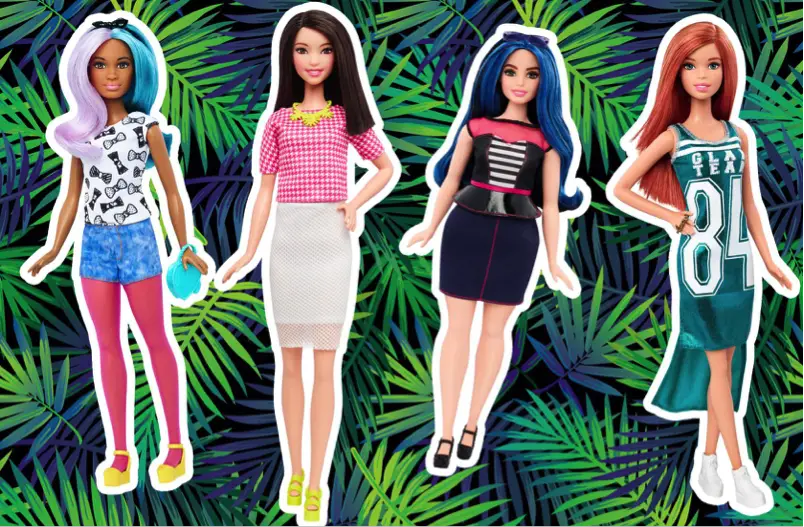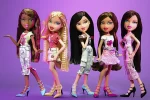Mattel, the toy company responsible for the pop culture phenomenon Barbie, made groundbreaking news recently for deciding to offer the doll in petite, tall and curvy body types.
And although this is a positive step for Barbie, the move comes after many years of negatively molding children’s perceptions of what the ‘ideal’ woman looks like.
It wasn’t too long ago that the 1965 Slumber Party Barbie, complete with bleach blonde hair and a silky pajama set, came equipped with a scale permanently set to 110 pounds. If that wasn’t enough to make a child self-conscious about their body, the included diet book plastered “DON’T EAT” in big lettering across the cover.
 Then, in an attempt to expand on their market share, Mattel introduced a slew of dolls throughout the ‘80s that were intended to represent different ethnicities. “Black Barbie,” “Hispanic Barbie” and “Oriental Barbie” were just a few examples of the racially questionable dolls that Mattel rolled out in their attempt to make the company seem more ‘culturally diverse.’ The stunt backfired though, as the new Barbie dolls did nothing but blatantly appropriate racial stereotypes.
Then, in an attempt to expand on their market share, Mattel introduced a slew of dolls throughout the ‘80s that were intended to represent different ethnicities. “Black Barbie,” “Hispanic Barbie” and “Oriental Barbie” were just a few examples of the racially questionable dolls that Mattel rolled out in their attempt to make the company seem more ‘culturally diverse.’ The stunt backfired though, as the new Barbie dolls did nothing but blatantly appropriate racial stereotypes.
Inspired by a German gag-gift for men, Barbie was the first adult doll made for children in the American market. Proto-Barbie’s purpose was to allow young girls to imagine and create their very own future. “Barbie always represented the fact that a woman has choices,” said Ruth Handler, co-founder of Mattel and creator of the Barbie doll. In fact, the plastic icon’s mission statement stressed that “Through the doll, the little girl could be anything she wanted to be.”
Among other jobs, Barbie has been a nurse, doctor, veterinarian, presidential candidate, flight attendant and astronaut, but despite her access to a variety of career choices, there never seemed to be any other choice for the doll besides an ultra feminine white woman that was beautiful and wildly successful.
Maybe she was just successful because of her looks? The point is, Mattel offered Barbie as the perfect woman, and they offered the perfect woman as a blonde, blue-eyed, big-breasted and tiny-waisted white woman. In some ways, yes, Barbie empowered young girls’ dreams to do anything they wanted, but any inspiration she meted out was always mitigated by her racial and physical homogeny.
In the 1940’s, Kenneth and Mamie Clark conducted an experiment called The Doll Test “to study the psychological effects of segregation on African-American children.” According to Brown at 60, “Drs. Clark used four dolls, identical except for color, to test children’s racial perceptions. Their subjects, children between the ages of three to seven, were asked to identify both the race of the dolls and which color doll they prefer. A majority of the children preferred the white doll and assigned positive characteristics to it.”
The test was reenacted back in 2012 and sadly still showed many young boys and girls designating the white doll as “pretty” and “nice” and the black baby doll as “mean” and “bad.” The fact that children still subconsciously believe in the superiority of white skin shows the failure of society to reform its archaic perceptions of race and beauty.
In another experiment, this one conducted in 2010, researchers found that girls who were made to taste food after playing with Barbies ate significantly less than when they played with average-sized dolls. The study nauseatingly reflects the extent to which girls are psychologically affected by the media.
 Still, despite their subliminally negative undertones, according to Telegraph a new Barbie is sold every three seconds; however, this number actually represents a decrease in sales since 2008, when three Barbies were sold every second. As a result, Mattel has taken efforts to uncover the reason for the doll’s waning popularity.
Still, despite their subliminally negative undertones, according to Telegraph a new Barbie is sold every three seconds; however, this number actually represents a decrease in sales since 2008, when three Barbies were sold every second. As a result, Mattel has taken efforts to uncover the reason for the doll’s waning popularity.
One likely answer for the drop in sales has to do with the actual inhumanity of the doll: Barbie’s anatomically impossible proportions have negatively affected the self-esteem of young girls for nearly 57 years. Research has shown that if Barbie were made into a real life teenager, she would be 5’9, have a 39” bust, an 18” waist, 33” hips and a size 3 shoe. She would weigh approximately 110 pounds and would be considered not only anorexic, but so thin that she wouldn’t even be able to walk.
Despite these historical faux paus, Mattel must be applauded for finally stepping into the 21st century and realizing that it is their obligation as influential toymakers to represent a broader spectrum of beauty.
The new Barbie model offers 7 different skin tones, 22 eye colors, 24 hairstyles and feet that are built for heels and tennis shoes. Hopefully, this expansion of the concept of beauty will allow girls and boys to grow up understanding that there is no ideal way to look, but instead that beauty comes in all shapes and sizes. After all, Mattel’s Barbie is designed for children ages 3-7, which is exactly the period at which children start developing their worldviews, especially their perceptions of beauty and body image.
And as inexcusable as their past oversights were, we can’t put the blame completely on Mattel. Like Barbie dolls, the media have been setting impractical standards of beauty for young kiddos for years, especially when it comes to celebrities and runway and print models.
 In the fashion world especially, women of all ages are led to believe that if you aren’t rail thin then you aren’t beautiful. To meet the needs of designers who want their garments to drape over models as if they were hangers, the average cat-walker has a BMI of at most 18, a depressingly unhealthy number.
In the fashion world especially, women of all ages are led to believe that if you aren’t rail thin then you aren’t beautiful. To meet the needs of designers who want their garments to drape over models as if they were hangers, the average cat-walker has a BMI of at most 18, a depressingly unhealthy number.
From this perspective, it is easy to scrutinize the fashion world and say that the principles that the industry follows are nothing but petty and superficial. How can any girl in our era of media oversaturation not be insecure about herself in comparison to the highly photoshopped celebrities and models that surround her?
Plus, it’s not just us mere mortals that fret over society’s standards of the perfect woman. Celebrities like Zendaya and Lorde have spoken out about recent alterations of themselves in photos. They were outraged to find out that their bodies were artificially altered to make them appear brighter in skin tone and skinnier.
When pointing out the enhancements, Zendaya said that “These are the things that make women self conscious, that create the unrealistic ideals of beauty that we have. Anyone who knows who I am knows that I stand for honest and pure self love.”
Like Zendaya and now Barbie, we should continue to teach young girls and boys what real, unmanipulated beauty looks like. It is neither one size, one number or one color, but rather many colors, many perspectives and many ways of being.
We need to stop letting the media be the arbiter of attractiveness and start loving one another in order to create a world filled with body-positive and health-conscious people.

















[…] set and dole out mental health advice? For years, any talk of Barbie would mean the impossible beauty standards she has set and how she impacted children’s perceptions of […]
[…] https://studybreaks.com/2016/02/11/plastic-pressure-barbies-impractical-beauty-standards-over-the-ye… […]
[…] note, on account of all the criticism faced by Barbie dolls for perpetuating gender stereotypes and unrealistic beauty standards, I suspect Mattel’s official stance on the Barbie doll being an “aspirational […]
[…] La representación de Barbie ha sido objeto de críticas debido a los estándares de belleza poco realistas que promovió durante muchos años. La figura esbelta y las características físicas ideales de Barbie han generado preocupaciones sobre su impacto en la imagen corporal de las niñas y las mujeres. Sin embargo, es importante reconocer los esfuerzos recientes de Mattel para abordar estas preocupaciones e impulsar una mayor diversidad y representación en sus muñecas[5]. […]